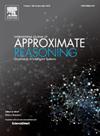具有Golazo惩罚的潜在高斯和h sler - reiss图形模型
IF 3
3区 计算机科学
Q2 COMPUTER SCIENCE, ARTIFICIAL INTELLIGENCE
引用次数: 0
摘要
在实际问题中,潜在变量的存在是很常见的,例如当一些变量很难或昂贵的测量,或根本是未知的。当未考虑潜在变量时,由于潜在变量引起的观察变量之间的额外相关性,高斯图形模型的结构学习可能会变得模糊。这个问题的标准方法是图形套索的潜在版本,它将逆协方差矩阵分成一个稀疏部分和一个低秩部分,分别进行惩罚。这种方法最近被成功地扩展到h本文章由计算机程序翻译,如有差异,请以英文原文为准。
Latent Gaussian and Hüsler–Reiss graphical models with Golazo penalty
The existence of latent variables in practical problems is common, for example when some variables are difficult or expensive to measure, or simply unknown. When latent variables are unaccounted for, structure learning for Gaussian graphical models can be blurred by additional correlation between the observed variables that is incurred by the latent variables. A standard approach for this problem is a latent version of the graphical lasso that splits the inverse covariance matrix into a sparse and a low-rank part that are penalized separately. This approach has recently been extended successfully to Hüsler–Reiss graphical models, which can be considered as an analogue of Gaussian graphical models in extreme value statistics. In this paper we propose a generalization of structure learning for Gaussian and Hüsler–Reiss graphical models via the flexible Golazo penalty. This allows us to introduce latent versions of for example the adaptive lasso, positive dependence constraints or predetermined sparsity patterns, and combinations of those. We develop algorithms for both latent graphical models with the Golazo penalty and demonstrate it on simulated and real data.
求助全文
通过发布文献求助,成功后即可免费获取论文全文。
去求助
来源期刊

International Journal of Approximate Reasoning
工程技术-计算机:人工智能
CiteScore
6.90
自引率
12.80%
发文量
170
审稿时长
67 days
期刊介绍:
The International Journal of Approximate Reasoning is intended to serve as a forum for the treatment of imprecision and uncertainty in Artificial and Computational Intelligence, covering both the foundations of uncertainty theories, and the design of intelligent systems for scientific and engineering applications. It publishes high-quality research papers describing theoretical developments or innovative applications, as well as review articles on topics of general interest.
Relevant topics include, but are not limited to, probabilistic reasoning and Bayesian networks, imprecise probabilities, random sets, belief functions (Dempster-Shafer theory), possibility theory, fuzzy sets, rough sets, decision theory, non-additive measures and integrals, qualitative reasoning about uncertainty, comparative probability orderings, game-theoretic probability, default reasoning, nonstandard logics, argumentation systems, inconsistency tolerant reasoning, elicitation techniques, philosophical foundations and psychological models of uncertain reasoning.
Domains of application for uncertain reasoning systems include risk analysis and assessment, information retrieval and database design, information fusion, machine learning, data and web mining, computer vision, image and signal processing, intelligent data analysis, statistics, multi-agent systems, etc.
 求助内容:
求助内容: 应助结果提醒方式:
应助结果提醒方式:


